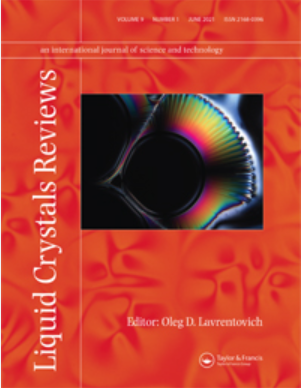POLICRYPS composite structures: realization, characterization and exploitation for electro-optical and all-optical applications
IF 4.2
3区 材料科学
Q2 CHEMISTRY, PHYSICAL
引用次数: 8
Abstract
The acronym POLICRYPS indicates a nano/micro composite structure made of films of well aligned nematic liquid crystal (NLC) alternated to slices of almost pure polymer. Structures are fabricated by curing a homogeneous mixture of mesogenic material, monomer and a curing agent with UV radiation, under suitable physical and geometrical conditions. In particular, geometrical conditions determine (in the range 0.2 ÷ 15 μ m) the spatial periodicity of the realized sample, which can be utilized for transmitting, diffracting or reflecting an impinging light beam, with negligible scattering losses. The spatial modulation of the refractive index (from polymer to NLC) can be switched ON and OFF both by applying an electric field of few V/μ m or, in some cases, by irradiating the sample with a light beam of suitable wavelength. This electrical/optical tuneability is responsible for a series of distinctive characteristics of the optical effects produced by the structure, and determines the range of possible applications. In fact, in different geometries, the POLICRYPS can be exploited as a switchable holographic grating, a switchable optical phase modulator, a switchable beam splitter, a tuneable Bragg filter or it can be exploited as an electro-optical edge filter in an optical interrogation system.polryps复合结构:电光和全光应用的实现、表征和开发
policyryps是一种纳米/微复合结构,由排列良好的向列液晶(NLC)薄膜和几乎纯聚合物片交替构成。结构是通过在适当的物理和几何条件下,用紫外线辐射固化介生材料、单体和固化剂的均匀混合物而制成的。特别是,几何条件决定了所实现样品的空间周期性(在0.2 μ m ~ 15 μ m范围内),该样品可用于透射、衍射或反射入射光束,散射损失可忽略不计。折射率的空间调制(从聚合物到NLC)可以通过施加几V/μ m的电场或在某些情况下用合适波长的光束照射样品来打开和关闭。这种电/光的可调谐性决定了该结构产生的一系列独特的光学效果,并决定了可能的应用范围。事实上,在不同的几何形状下,POLICRYPS可以用作可切换全息光栅、可切换光学相位调制器、可切换分束器、可调谐布拉格滤波器,或者可以用作光学询问系统中的光电边缘滤波器。
本文章由计算机程序翻译,如有差异,请以英文原文为准。
求助全文
约1分钟内获得全文
求助全文
来源期刊

Liquid Crystals Reviews
CHEMISTRY, PHYSICALCRYSTALLOGRAPHY&n-CRYSTALLOGRAPHY
CiteScore
7.60
自引率
5.90%
发文量
8
期刊介绍:
Liquid Crystals Reviews publishes review articles on all aspects of liquid crystal fundamentals and applied science, including experimental and theoretical studies of physical and chemical properties, molecular design and synthesis and engineering of liquid crystal devices. The Journal fosters cross-disciplinary exchange of ideas, encouraging authors to present material at a level accessible to specialists from other fields of science and engineering. Liquid Crystals Reviews provides the scientific community, in both academia and industry, with a publication of standing, guaranteed by the Editors and by the International Editorial Board who are active scientists in the worldwide liquid crystal community.
 求助内容:
求助内容: 应助结果提醒方式:
应助结果提醒方式:


